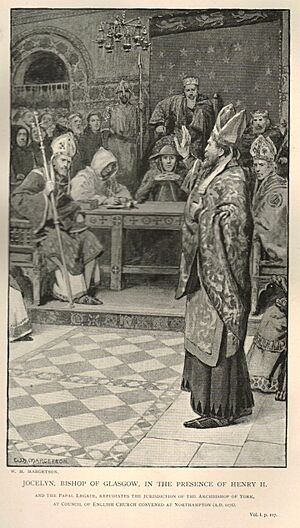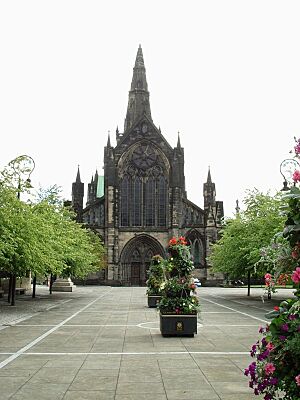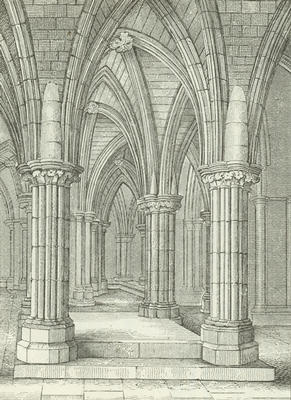Jocelin of Glasgow facts for kids
Quick facts for kids Jocelin |
|
|---|---|
| Bishop of Glasgow | |
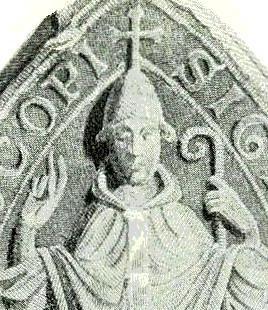 |
|
| Church | Roman Catholic Church |
| See | Diocese of Glasgow |
| In Office | 1174/5 – 1199 |
| Predecessor | Enguerrand |
| Successor | Hugh de Roxburgh |
| Orders | |
| Consecration | 1175 |
| Personal details | |
| Born | 1130s Scottish Borders or Northumberland |
| Died | 17 March 1199 Melrose |
| Previous post | Abbot of Melrose |
Jocelin (sometimes spelled Jocelyn) was an important church leader in the 1100s. He was a Cistercian monk and a cleric, which is a person who works for the church. He became the fourth Abbot of Melrose, a leader of a monastery. Later, he became the Bishop of Glasgow in Scotland.
Jocelin was probably born in the 1130s. When he was a teenager, he joined Melrose Abbey as a monk. He became very important in the abbey, eventually becoming its leader (abbot) in 1170. As abbot, he helped make Saint Waltheof famous.
In 1174, Jocelin became the Bishop of Glasgow. This was a very important job. He also worked for the king, William the Lion. He traveled to other countries and even performed the wedding ceremony for King William and Ermengarde de Beaumont. Later, he baptized their son, who would become King Alexander II of Scotland.
Historians say Jocelin was very important for Glasgow. He is known for starting the town (called a burgh) of Glasgow and creating the famous Glasgow Fair. He also supported writers and artists. He asked people to write important books like the Life of St Waltheof, the Life of St Kentigern, and the Chronicle of Melrose.
Contents
Jocelin's Early Life and Becoming a Monk
Jocelin and his family likely came from the south-east of Scotland. We don't know his parents' names. But he had two brothers, Helia and Henry, and a cousin also named Helia. These names suggest his family might have been of French or Anglo-Norman background.
His family might have owned land in South Lanarkshire. This is because they seemed to have rights in the church of Dunsyre. It's important to remember that in Jocelin's time, people in this part of Britain often thought of it as "the Land of English," even if it was in the "Kingdom of the Scots."
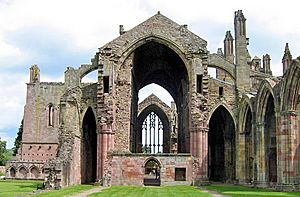
We don't know exactly when Jocelin was born. But we know he joined Melrose Abbey as a new monk around 1148-1159. He likely joined about 50 years before he died in 1199. Cistercian rules said you had to be at least 15 to become a new monk. So, he was probably born around 1134.
Jocelin's early time as a monk isn't well known. But he finished his training year successfully. The abbot at the time, Waltheof, thought highly of him and gave him many duties. After Abbot Waltheof died, the next abbot, William, didn't like the stories spreading about Waltheof being a saint. Abbot William tried to stop these stories. He also wanted to keep pilgrims from bothering the monks.
However, Abbot William couldn't stop Waltheof's growing fame. His actions also made the other monks unhappy. Because of this, William resigned as abbot in April 1170. By this time, Jocelin was the Prior of Melrose. This meant he was the second-in-command at the monastery. So, he was the most likely person to replace William.
Jocelin as Abbot of Melrose
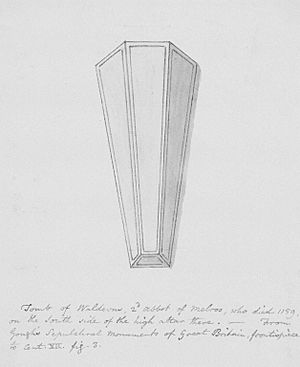
Jocelin became abbot on April 22, 1170. He fully supported the idea of Waltheof being a saint. The Chronicle of Melrose, a historical record, reported something special in the year Jocelin became abbot:
The tomb of our good father, sir Waltheof, the second abbot of Melrose, was opened by Enguerrand, the bishop of Glasgow, and by four abbots. His body was found whole, and his clothes were still good, twelve years after his death, on May 22. After a holy mass, the bishop and the abbots placed a new stone of polished marble over his holy body. Everyone was very happy, shouting that he was truly a man of God.
Jocelin would do something similar in Glasgow. He became very interested in St Kentigern, who was the main saint for the Glasgow area. He asked someone to write a special book about St Kentigern's life. It's interesting that the same person, Jocelin of Furness, wrote both the Life of St. Waltheof and the Life of St. Kentigern.
Jocelin also started the writing of the Chronicle of Melrose. Historian Archie Duncan believes Jocelin asked a monk named Reinald to write down events from 731 to 1170. This chronicle is one of the few historical records from Scotland during that time.
Even after he became Bishop of Glasgow in 1174, Jocelin still had a lot of influence at Melrose Abbey. He brought one of his monks, Michael, to be his assistant in Glasgow. Jocelin didn't officially leave his abbot position until after he became a bishop in 1175. He even helped choose and bless the next abbots of Melrose. He also used his power as bishop to help and protect the monastery.
Jocelin as Bishop of Glasgow
After his friend Bishop Enguerrand died, Jocelin was chosen to be the Bishop of Glasgow. He was elected on May 23, 1174. The election happened in front of King William the Lion at Perth. This was near Scone, where Scottish kings often lived. The Chronicle of Melrose says he was chosen "by demand of the clergy, and of the people; and with the consent of the king himself."
It was a big achievement for Jocelin. Cistercian bishops were rare in Britain. Jocelin was only the second Cistercian to become a bishop in Scotland. He had to travel to France to get permission from the Cistercian order to leave his abbot role. Pope Alexander III had already approved his becoming a bishop.
Jocelin was consecrated (officially made a bishop) by Eskil, an important church leader from Denmark. This happened at a Cistercian monastery called Clairvaux Abbey before March 15, 1175. Jocelin returned to Scotland by April 10. On May 23, he helped consecrate Laurence as his replacement at Melrose.
Soon, Jocelin faced a challenge to the independence of his church. This challenge came from the English church. In 1174, King William of Scotland was captured by King Henry II of England. This led to a treaty called the Treaty of Falaise. This treaty made King William a servant of King Henry. It also said that Scottish bishops should be under the English church.
But Jocelin did not give in to the English archbishops. He got a special letter from the Pope, called a Papal Bull. This letter said that the Glasgow church was a "special daughter" of Rome. This meant it was directly under the Pope, not under the English church. Jocelin seemed mostly interested in keeping Glasgow's independence, not necessarily all other Scottish churches.
Jocelin traveled to England with King William in 1175 and 1176. During one visit, the Archbishop of York tried to make Jocelin agree that Glasgow was under York. But Jocelin refused and showed him the Papal Bull. This Bull was later confirmed by a new Pope, Pope Lucius III. Jocelin got this confirmation when he visited Rome in 1181-1182.
Jocelin was sent to Rome by King William to solve a problem about the Bishopric of St Andrews. The Pope had punished the king and Scotland. Jocelin's trip was successful. The Pope lifted the punishment and sent people to investigate the St Andrews issue.
Jocelin was clearly one of the most respected people in Scotland. The Pope often chose him to be a judge in church disputes. Other bishops and monasteries asked him to help settle arguments. He also had the respect of important non-church leaders. He witnessed many important documents for King William and other powerful people.
Jocelin was with King William when he visited the English court in 1186. He also went with the king to Woodstock for his marriage to Ermengarde de Beaumont. Bishop Jocelin blessed their marriage. When their son, the future King Alexander II, was born, Jocelin performed the baptism. Jocelin's close relationship with the king helped him do great things for Glasgow.
Jocelin's Impact and Death
Jocelin's time as Bishop of Glasgow left a huge mark on history. He asked Jocelin of Furness, the same writer who wrote about St Waltheof, to write a book about St Kentigern. St Kentigern was the traditional saint of Glasgow. Making him more famous helped Glasgow's church become more important.
There was already a church in Glasgow before Jocelin became bishop. But Jocelin made the cathedral much bigger. The Chronicle of Melrose says that in 1181, Jocelin "gloriously enlarged the church of St Kentigern." However, a fire damaged the cathedral sometime between 1189 and 1195. So, Jocelin had to start another rebuilding project. The new cathedral was officially opened on July 6, 1197. It was built in the Romanesque style. Not much of it is left today, but it might have been influenced by the cathedral of Lund in Denmark.
Jocelin also left an even bigger mark on the city of Glasgow itself. Between 1175 and 1178, he got permission from King William to make Glasgow a royal burgh. This meant Glasgow became an official town with its own market every Thursday. This was the first time a weekly market was officially granted to a town.
Later, between 1189 and 1195, King William gave Glasgow permission for an annual fair. This fair still happens today! This made Glasgow an even more important place. These new rights brought more people to Glasgow. The new town was planned around Glasgow Cross, downhill from the cathedral.
Jocelin died back at Melrose Abbey, where he had started his church career. He might have gone there knowing he was close to death. He passed away on St Patrick's Day, March 17, 1199. He was buried in the monks' choir at Melrose Abbey Church. Hugh de Roxburgh, who was the King's Chancellor, was chosen to replace Jocelin as Bishop of Glasgow.



